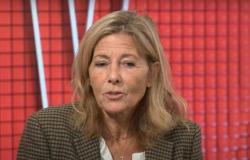[Article publié le vendredi 27 septembre à 14H55, mis à jour à 15H30] Prices rose less than expected in August in the United States. Over one year, the PCE index increased by 2.2% last month against 2.5% in July, and 0.1% over one month against 0.2% in July, according to figures published by the Commerce Department this Friday. Above all, it is slowing down more than expected since economists surveyed by Reuters expected on average an increase in the PCE index of 0.1% over one month and an increase of 2.3% year-on-year.
The underlying inflation index core PCE », which excludes the volatile elements such as energy and food products, increased by 0,1% in August, compared to 0.2% in July. On the other hand, over one year, the index rose to 2,7%, compared to 2.6% in July. Economists expected 0.2% over one month and 2.7% over one year.
Note, the PCE index is the one favored by the Fed which wants to see it return to a rate of 2%. The other major index, the CPI, fell to +2.5% year-on-year in August, compared to +2.9% in July, according to figures from the Labor Department on September 11.
As price inflation subsides, so does consumer spending by American households. The latter increased in August by 0,1%, compared to 0.4% in July, according to the Commerce Department. On an adjusted basis, overall consumer spending increased by 0,2% the last month, compared to 0.5% in July.
The Fed sharply lowers the key rate, good news or bad?
The Fed enters a rate cut cycle
The August figures confirm the slowdown in inflation across the Atlantic. The American Central Bank even today anticipates inflation at 2.3% at the end of 2024 and 2.1% at the end of 2025, when in June, during previous forecasts, it expected 2.6% and 2.3% respectively, then return to the target level of 2.0% in 2026.
A slowdown which has also pushed it to lower its rates by half a percentage point, a first since 2020, to 4.75-5.00%, on September 18.
« This decision reflects our growing confidence that with an appropriate recalibration of our policy, the strength of the labor market can be maintained in a context of moderate growth and inflation falling sustainably towards 2% “, declared Jerome Powell, the president of the institution, during a press conference following the institution’s meeting.
The decision was not taken unanimously, however, during this last meeting before the American election on November 5, one governor, Michelle Bowman, having voted for a reduction of only a quarter of a point.
Fed: markets remain hesitant about the extent of the rate cut
There was no room for doubt as to the launch by the institution of a cycle of monetary easing. Only uncertainty remained over the extent of this first drop since 2020. As a reminder, the Fed raised its rates to 5.25 to 5.50% to try to curb the surge in prices.
The monetary institution also plans to further lower its rates by a half point in total by the end of 2024. This is good news since in June, the Fed thought it would lower rates only once in 2024, by a quarter of a point. point.
Inflation slows sharply in France in September
The situation is not only improving in the United States. In France, prices increased by 1.2% over one year in September, a sharp decline compared to the inflation of 1.8% recorded in August, INSEE indicated this Friday in a first estimate. Over one month, the consumer price index fell by 1.2% in September. It is “ the strongest monthly drop in prices since the start of the series (statistics, editor’s note) in 1990 », underlines INSEE.
« In addition to the seasonal effect of the drop in the price of transport (notably air) and accommodation services, there is in particular the marked drop in energy prices and the return to normal of certain prices after the Olympic Games. and Paralympics and the drop in the price of health services », list the national statisticians. “ Conversely, the prices of manufactured products should increase over one month, driven by the increase in the prices of clothing and shoes. », adds INSEE.
(With Reuters)






